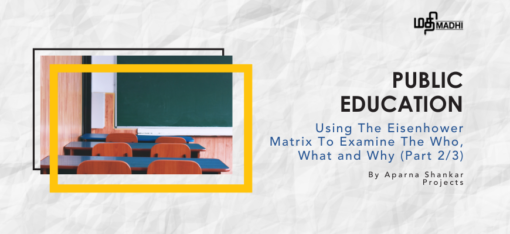
Public Education: Using The Eisenhower Matrix To Examine The Who, What and Why (Part 2/3)
Part 2 will delve into the nuances of the lifetime human need for education, from the perspectives of equitable delivery and uniformity.
In the preceding article, we proposed that a well designed and equitably delivered education system could become a key lever towards achieving poverty alleviation. Additionally, we discussed the necessity for state actors to strategically apply decision making principles to determine the allocation of limited state resources. We also purported that the Eisenhower Matrix could be a useful tool to make such allocation decisions.
This article will examine the lifetime human need for education, from the perspectives of equitable delivery and uniformity. We had earlier discussed that the primary objective of state provided education should be to offer access to learning, such that it can augment a citizen’s overall quality of life. It can do so by providing a pathway to meaningful livelihood opportunities, as a result of the education received*. Life today is sharply different from what it was in 2004 (when children, who are 21 today, began their learning journey in LKG); technology and lifestyles are altering at a faster pace than we have encountered before. Accordingly, it is necessary to prepare children who enter the education system today for the world of work that they will encounter in 2035; the expected year for children in 1st grade today to turn eighteen.
Keeping this objective in mind, we can categorise the lifetime human need for education into the following four groups, each bearing the following features:
1. Primary Learning
Education received between the ages of 5 and 12
Here, the objective of education should be to build foundational knowledge and skills amongst children; focussing on encouraging children to use their intellect to build the hard skills of literacy, comprehension, numeracy, and the softer skills of effective communication and critical thinking.
It is necessary to deliver such education in as uniform a manner as possible to ensure that the building blocks of learning for each child remain the same. It is only when the foundation for learning is delivered in an equitable manner, that we can ensure that all children will start their lifelong journey of learning on as level a playing field as possible. Viable customisations to the learning delivery in this context could be to alter the medium of instruction, such that learning occurs in a child’s native language, however the curricular content imparted should remain the same..
Attaining mastery in foundational literacy and numeracy skills will ensure that the child will be able to learn proficiently, no matter what their future choice of subject or professional pathway will be. Learning to read to read to learn is an old adage which exemplifies this line of reasoning; mastery in foundational skills has been noted as being critical to being able to successfully function in Industry 4.0.
2. Secondary or High School Learning
Education received between the ages of 13 and 18
Here, the objective of education should be to provide young people with the opportunity to explore a variety of different subject pathways, build further technical knowledge across all segments of learning, gain meaningful career counselling and gain a deeper understanding of entrepreneurial and critical thinking.
It is necessary to deliver such types of education where the skeletal components of delivery and the access to various subject pathways are uniform. However, research has shown that there is merit in customising the finer details of the education imparted to suit local contexts, opportunities and labour market conditions.
During this period, young people should be able to meaningfully engage in planning the trajectory of their professional development; identifying where their interests lie, choosing whether they want to build traditional careers, choose vocational professions or choose entrepreneurialism** as a means to their livelihoods. This period of learning should be the building block for ascertaining the professional trajectory of one’s career path.
3. Workforce Ready Education
Education received from the age of 18 onwards, designed to make the learner workforce ready
Traditionally, such education has been in the form of university learning, vocational training or informal apprenticeships. Here, the objective of education should be to prepare people to enter the workforce, and learn the key skills which will enable them to successfully work in their chosen field meaningful, applied career counselling which can support learners in making the correct decisions related to their careers.
It is necessary to deliver such education such that the primary components of the learning should be customisable to the specific workforce needs and the primary components of career counselling should be customised to the learners needs. However, an element of uniformity should remain in imparting the core, transferable competencies needed to thrive in Industry 4.0.
During this period, people should be able to select a career trajectory that is suitable to their skill sets and interests, fits the trend of labour market demands, and allows them to learn the applied skills required to thrive in their chosen career.
4. Lifelong Learning Opportunities
Education received by adults, through their lifetime, designed to support the learner in either imbibing further knowledge to gain the necessary skills which are required to remain professionally relevant
Traditionally, such education has largely been delivered by either industry or the public sector; the former aiming to upskill their workforce and the latter aiming to reduce the rate of unemployment. Here, the objective of the education imparted should be to engage adult learners with the specific knowledge and skills they require to improve their ability to do a particular job.
It is necessary to deliver such education in a manner as contextual, customised and targeted as possible, as research has shown that most adult learners will be best motivated to learn when they can visualise the material impact that the learning will have on their daily professional growth. It is not necessary to maintain any uniformity in the service delivery of this category of learning, because there is an implicit expectation that learners will be best placed to decide what manner of learning will best suit their needs. There is however a need to maintain uniformity in providing access to opportunities for lifelong learning, particularly as research postulate that the average worker will alter their professional trajectory multiple times in Industry 4.0.
The following diagram describes the extent of uniformity or customisation that each category of lifetime education requires to ensure equitable access to learning.
Let us assume that due to limited resource availability, the state system cannot equitably provide access to quality education for the entire spectrum of lifetime human needs. Let us further assume that while the state cannot itself deliver the entire spectrum of education required, it can create a conducive environment through policy decisions and targeted regulation which will ensure access to the spectrum of learning and support which citizens need, in a reasonably equitable manner. For example, to ensure equitable access to Workforce Ready Learning, the state can mandate that non-banking financial companies (NBFCs) must provide universal, affordable access to credit such that learners from lower income backgrounds can also obtain the necessary support required to develop a meaningful career. It can further establish the framework against which educational institutions will be held accountable for delivery of quality education.
Given this context, how do you think each of the components of lifetime education should be categorised into an Eisenhower Matrix, contextualised for state decision making. How would you allocate resources keeping in mind the necessary urgency or importance of each of the four categories of the lifetime need for human education?
*Sustainable Development Goal 4 (SDG 4) is the education goal. It aims to “ensure inclusive and equitable quality education and promote lifelong learning opportunities for all”.
**By focusing on entrepreneurial skills as a core competency, the Indian education system can also become inclusive to the needs of the informal and agricultural sector; which account for approximately 60% of national income in India and are slated to account for a larger proportion of income as production becomes increasingly automated.

